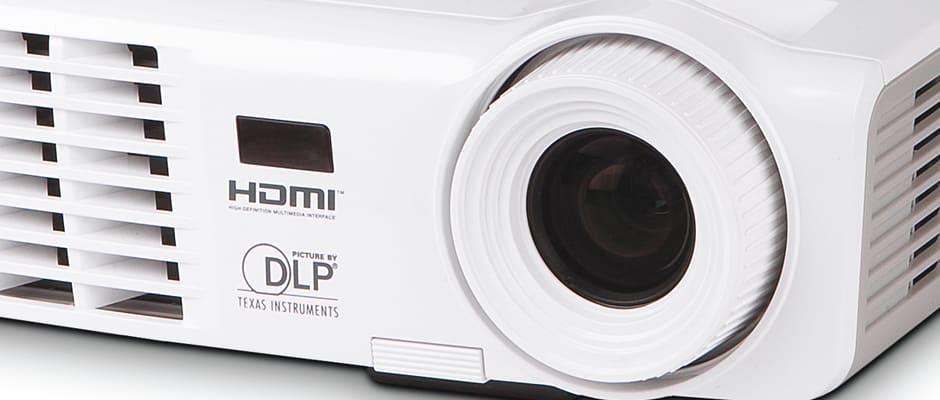Introduction
Front
The Vivitek D537W is an average looking projector. It doesn’t feel like the sturdiest piece of technology we’ve seen, but neither is it the cheapest. We have no faith in the little carrying bag that they provide, so plan on buying some padding if you want to tote this thing around. Our biggest complaints about the design is the poor construction of the zoom and focus rings. They’re difficult to turn with any precision and feel extremely cheap low-grade. The adjustable foot in the front is equally cheap. We expect that when you push the foot-release button on the front, the foot should drop down. Instead, you have to hold the button and jiggle the leg to fall. Like we said… a little cheap.
{{section_header}}{{section.name}}{{/section_header}}
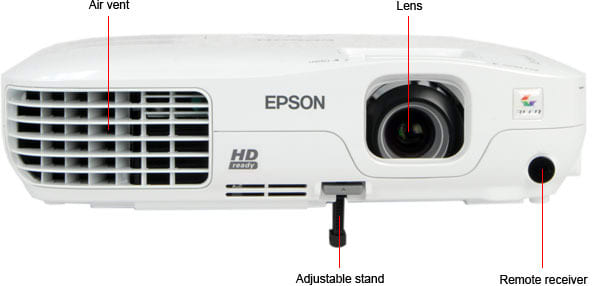
Back
{{section_header}}{{section.name}}{{/section_header}}
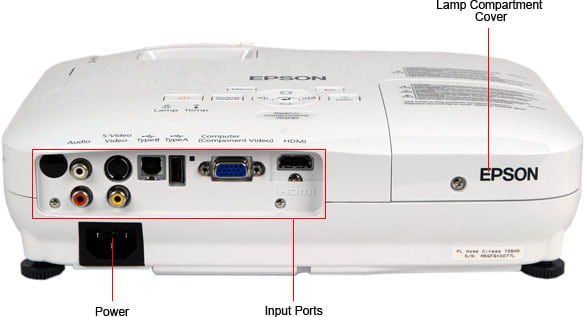
Sides
{{section_header}}{{section.name}}{{/section_header}}
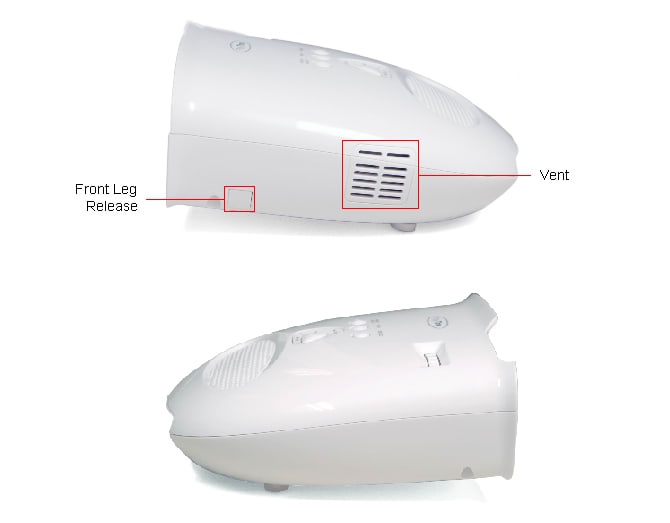
Top/Bottom
{{section_header}}{{section.name}}{{/section_header}}
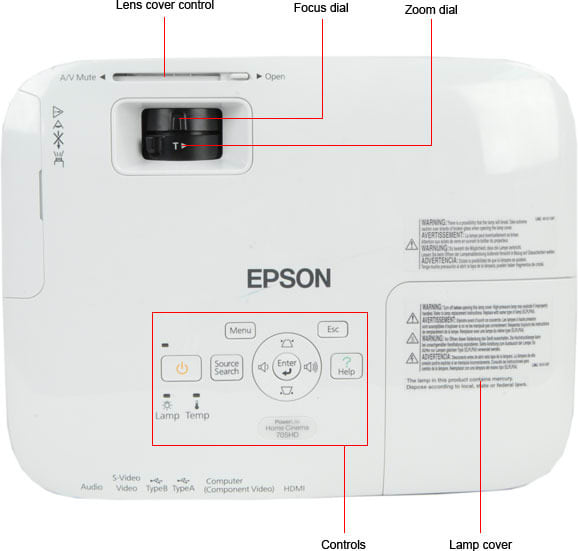
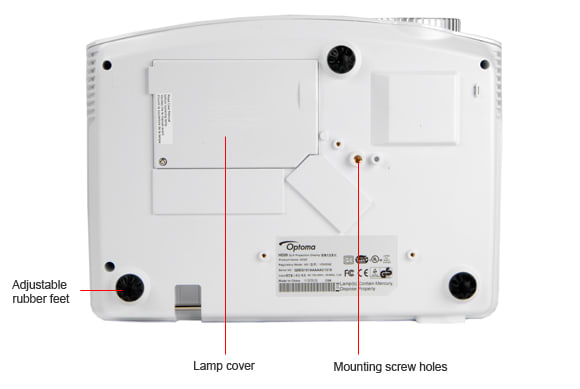
Lamp
Remote Control Tour
{{section_header}}{{section.name}}{{/section_header}}
The remote control that ships with the Vivitek D537W is remarkably cheap, and more like something you'd get with a $100 stereo than a mid-priced projector. The buttons aren't separate pieces of rubber, but rather little bumps that rise from the surface. They're uncomfortable, difficult to differentiate by touch, and unresponsive. The size makes it easy to misplace or slip between a crack, but at least it's lightweight.
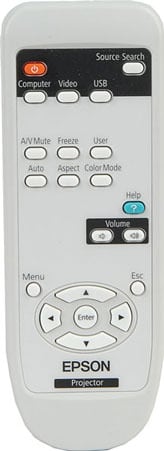
The small remote control of the 705HD
In the Box
{{section_header}}{{section.name}}{{/section_header}}
The Vivitek D537W ships with:
* Remote control
* AC power cable
* Remote control
* VGA cable
* Carrying case
* CD-ROM with user's manual
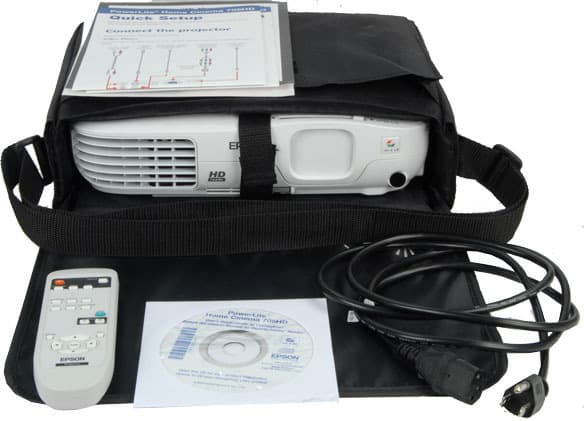
The 705HD comes with a carrying case, manuals, power cable and remote
Portability
{{section_header}}{{section.name}}{{/section_header}}
Measuring 10.3"x 3.1" x 7.5" (261 x 78 x 190mm) and weighing 4.2 lbs, (1.9kg), it's not a terribly large or heavy projector. Of course, it's far from a pico projector, but you get a much better image quality with something this size.
{{product.raw_scores['Portability']}}
Setup Assistance
{{section_header}}{{section.name}}{{/section_header}}
Provided your computer can handle the 1200 x 800 resolution, you'll be able to drive the Vivitek D537W natively. If you plan on using this as a video projector, it can handle all standard NTSC formats through the HDMI ports. You can so standard-def signals through the composite and S-video ports.
There is no auto-keystoning or other auto-setups on the Vivitek D537W, but you can set it to automatically recognize the video source when you plug it in.
{{product.raw_scores['Setup']}}
Aesthetics
{{section_header}}{{section.name}}{{/section_header}}
The Vivitek D537W is simple and discreet, an unassuming white and grey rectangle.
Peak Brightness
The Vivitek D537W gets plenty bright, but the modes that offer more color accuracy are significantly dimmer.
{{section_header}}{{section.name}}{{/section_header}}
While the Vivitek D537W doesn't quite match up to the peak brightness of the ViewSonic PJD6531w, it's admirably close, topping out at 2855 cd/m2.
Peak Brightness
Like most projectors, there are several user modes on the Vivitek D537W, and they have a huge impact on the brightness output. As you might expect from the name, the Bright mode has a brightest whites, and we scored these sections based on its performance in this mode. However, bright modes like this typically throw the color performance under the bus, so understand that there's a time and a place for each mode that's largely dependent on the ambient lighting in the room. The most color-accurate mode, which was our calibrated User mode, has a drastically lower peak brightness.
Peak Brightness
Tunnel Contrast
{{section_header}}{{section.name}}{{/section_header}}
The Vivitek D537W did not have too much of a problem maintaining a consistent black level. Only when the black area is a very small percentage of the screen, about 5-15%, did the brightness of that black start to rise considerably.
Tunnel Contrast
Uniformity
{{section_header}}{{section.name}}{{/section_header}}
Projectors do not display an even illumination across the screen, typically. As you can see in the chart below, the Vivitek D537W's luminance bounced around considerably, with the bright portions in the center, then trailing off towards the edges. This is about the same performance as we've seen with similarly priced projectors.
Uniformity
Greyscale Gamma
{{section_header}}{{section.name}}{{/section_header}}
The greyscale gamma measures how well a projector transitions from white to black within the greyscale. The chart below tells us several things. First, we're looking at the smoothness of the line. There are virtually no bumps, so you can expect smooth gradients in the greyscale from the Vivitek D537W. Secondly, we're looking at the evenness across the intensity range. Some projectors lack detail in the shadows, others lack it in highlights. The Vivitek D537W was good enough to provide even luminance throughout the range. Finally, we're looking at the slope of the curve. An ideal slope is between 2.1 and 2.2. The Vivitek D537W's performance of 2.3 is very close, but a bit steep.
Greyscale Gamma
Color Temperature
The Vivitek D537W’s color performance is very good, overall.
{{section_header}}{{section.name}}{{/section_header}}
The Vivitek D537W's color temperature was remarkably consistent. From the brightest to the darkest signal intensity, you won't see a single deviation. Sure, there's a little wavering that you can see in the chart below, but all of it is too minor to be perceived by the human eye.
Color Temperature
RGB Curves
{{section_header}}{{section.name}}{{/section_header}}
The color performance of the Vivitek D537W was exemplary in our RGB testing. The curves were smooth, the three channels moved in unison, and we saw good detail in both the shadows and the highlights. This performance is better, sometimes far better, than the three projectors we've pulled in for comparison.
RGB Curves
Color Gamut
{{section_header}}{{section.name}}{{/section_header}}
The Vivitek D537W was not matched up too closely to the rec. 709 color standard, but it wasn't any further off than the three similarly priced projectors we used for comparison. The greens were a little yellow, the reds were a little orange, and the blues were a little light-blue. Overall, the performance is not too bad.
Color Gamut
Motion Smoothness
{{section_header}}{{section.name}}{{/section_header}}
We run a number of patterns across the screen when we look at motion performance. We're happy to report that scenes with people in them look pretty good. The smoothness issues that we saw were more apparent in test patterns that are inherently more challenging to a projector. The biggest problems were seen in high contrast, high frequency patterns, in which we saw a lot of clipping, strobing, and stair-stepping.
Motion Artifacting
{{section_header}}{{section.name}}{{/section_header}}
The Vivitek D537W did not have a terrible amount of artifacting. Unlike a lot of TVs and projectors, there was almost no color trailing or ghosting around high contrast areas. As we mentioned above, the biggest problem area was high contrast, high frequency black & white patterns. In those instances, we saw a lot of false coloration.
3:2 Pulldown & 24fps
{{section_header}}{{section.name}}{{/section_header}}
The Vivitek D537W had no problems displaying native 24fps content. In certain scenes, especially slow panning shots, you'll notice a slight judder, but most projectors have this problem.
Resolution Scaling
{{section_header}}{{section.name}}{{/section_header}}
The Vivitek D537W has a native 1200 x 800 resolution, which is not what any NTSC video sources use. Fortunately, the projector does a good job of re-scaling the data to fit the screen.
480p
When we looked at 480p content, the Vivitek D537W showed some slight problems with high contrast, high frequency patterns, as well as black-on-white text.
720p
The 720p content had all the same strengths and weaknesses of 480p.
1080p
The biggest problem was 1080p footage, which should terrible Moire patterns in high frequency patterns. If we displayed paragraphs of text on the screen, you could see "waves" of varying line thickness.
3D Readiness
{{section_header}}{{section.name}}{{/section_header}}
Yes, the Vivitek D537W is capable of 3D performance, but it's not ready to roll straight out of the box. In order to actually see a 3D image, you'll need to buy additional equipment, like the kits nVidia sells that include glasses and an IR device that the sync the glasses to the refresh rate of the projector. That will run you about $200.
Throw
A very small zoom lens gives the Vivitek D537W some flexibility.
{{section_header}}{{section.name}}{{/section_header}}
The Vivitek D537W has a 1.15x zoom ratio. That's not much, but it gives you a small amount of flexibility in terms of placement. At minimum, the projector requires about 7 feet for a 64-inch screen. After that, it depends on your screen size, but you'll only have to move further back. It's definitely not a "short-throw" projector.
Screen Brightness
{{section_header}}{{section.name}}{{/section_header}}
Projectors lose brightness as they move further from the screen, and as we discussed above the larger the screen the further away you'll have to place the projector. The table below has all the details.
As with any projector, the outputted light is in competition with ambient room light. We have created the table below that gives a simple pass/fail for various screen sizes and levels of ambient light. Overall, the Vivitek D537W did pretty well.
Below are some photographs we took of the Vivitek D537W's actual performance in varying ambient light levels.
Screen Materials
{{section_header}}{{section.name}}{{/section_header}}
The Vivitek D537W offers a number of settings that correct color for various wall colors. Options include: Light Yellow, Pink, Light Green, Blue, and Blackboard. We're not saying that it will correct the colors perfectly, but at least they're trying.
Optical Issues
{{section_header}}{{section.name}}{{/section_header}}
The Vivitek D537W did not do the best job with certain types of patterns. We've included some photos below to illustrate our findings, but they only tell a portion of the story. Each of those little dots should be a single pixel, but sometimes they smeared over 2-4 pixels, especially as you get further from the center of the image. Thin, solid lines also showed some ghosting.
Video Processing
{{section_header}}{{section.name}}{{/section_header}}
The Vivitek D537W has a small number of video processing features, but they don't seem to be available if you have an HDMI or VGA cable running the feed.
Formats
{{section_header}}{{section.name}}{{/section_header}}
The Vivitek D537W has a native resolution of 1280 x 800, also known as WXGA. This is close, by not identical to the HD resolution of 1280 x 720, also known as 720p. Like most projectors, it can handle a large variety of formats (UXGA, WXGA+, WXGA, SXGA+, SXGA, XGA, SVGA, VGA Resized; VESA Standards in the computer formats, along with standard NTSC, PAL, and SECAM formats).
Calibration
{{section_header}}{{section.name}}{{/section_header}}
When we calibrated the Vivitek D537W we were using the HDMI connection. That turned out to have an impact on our experience, because many menu settings are not available when using certain ports. For instance, most of the processing features with the word "Video" in front of it did not work if you were driving the video through anything but composite of S-video. Also, if you choose any mode other than User mode, you can't change any of the settings, not even contrast, color temperature, etc.
Video Modes
{{section_header}}{{section.name}}{{/section_header}}
There are a many video modes, but only User mode allows you to make changes to the performance settings.
Input Ports
{{section_header}}{{section.name}}{{/section_header}}
The Vivitek D537W comes equipped with basic ports only: an HDMI, VGA, S-Video, and composite AV inputs. There's also an RS-232C connector for remotely controlling the projector. This certainly lacks some of the ports a higher-end projector might have, but the D537W is intended to be portable, not robust. If you want to input DVI or composite video, you'll need to buy an adapter.
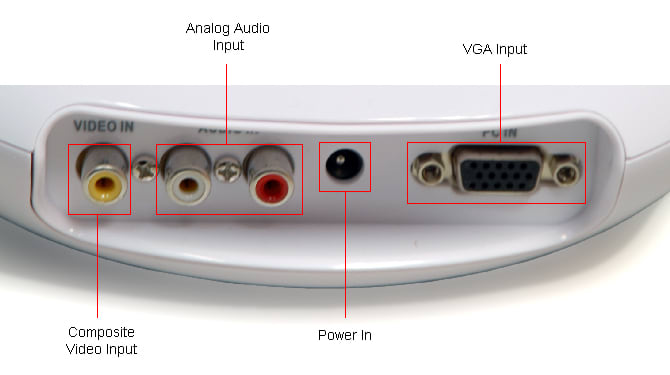
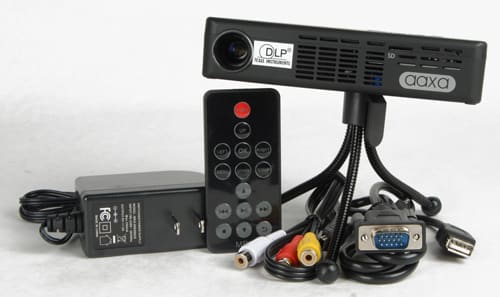
Lots of cables are included
All the ports are listed below, compared with the competition.
Other Connections
{{section_header}}{{section.name}}{{/section_header}}
The Vivitek D537W also has an RS-232C port that allows you tech-heads out there to do tighter calibrations and other functions.
Placement
{{section_header}}{{section.name}}{{/section_header}}
All the ports on the Vivitek D537W are located on the back of projector, easy to access and well-labeled. The only one that gave us trouble is the HDMI port, located so close to the top and tucked under a little ridge that we nearly missed it.
Internet & Media Features
Menus & Manual
{{section_header}}{{section.name}}{{/section_header}}
The Vivitek D537W's onscreen menus are a little frustrating, mostly because the remote control is terrible and a lot options are greyed-out depending on what mode you're in. Thankfully, the menu's structure is pretty clear, so you always know where you are.
There's no printed instruction manual that comes in the box. Vivitek includes a CD-ROM with a digital version, and you can also download one from their site here. The manual offers very little information. For instance, they describe the Film Mode feature thusly: "Press the buttons to adjust Film Mode." Thanks, Vivitek.
Noise
{{section_header}}{{section.name}}{{/section_header}}
The Vivitek D537W produced an average 46 decibels when operating in the brightest mode, or 41 decibels when in eco mode. This is about average for similarly sized and priced projectors.
{{image_chart title="Noise", attachment="Noise Graph"}}
Heat
{{section_header}}{{section.name}}{{/section_header}}
All projectors kick out a lot of heat if you stand too close to them. The temperature of the exhaust fan is a whopping 69 degrees (F) warmer than the ambient air. That can get uncomfortable, so plan on mounting the projector on the ceiling, or give a wide berth around the exhaust port.
{{image_chart title="Heat", attachment="Heat Graph"}}
Power Consumption
{{section_header}}{{section.name}}{{/section_header}}
The Vivitek D537W consumes about the same amount of power as similar projectors. The wattage varies pretty widely depending on the mode you've chosen. Obviously, something like Eco mode is going to use less power. The table below has all the details from four different modes.
Lamp Life
{{section_header}}{{section.name}}{{/section_header}}
Vivitek claims that the 5811116310-SU lamp has a reported life of 3000 / 4000 hours, based on Normal / Eco modes. We don't have the time to test all 3000-4000 hours of that claim, so we have to take them at their word, to some degree. They're probably exaggerating, but hopefully not by too much.
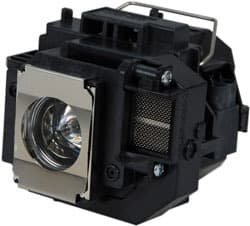
The lamp of the 705HD
Value
{{section_header}}{{section.name}}{{/section_header}}
The ViewSonic PJD6531w has roughly the same price as the Vivitek D537W. Overall, the performance was rather good. It produced a brighter image, but the color performance was not as good. It's a little bulkier, which decreases the portability. The ViewSonic has far more ports, which might make it a little better for home theater.
Blacks & Whites
{{section_header}}{{section.name}}{{/section_header}}
The ViewSonic PJD6531w outshined the Vivitek D537W in our brightness tests. In fact, few projectors we've reviewed so far have topped the ViewSonic. That could come in handy in a bright room. The ViewSonic also produced a more even illumination across the screen.
{{image_chart title="Contrast", attachment="Contrast Graph"}}
Color
{{section_header}}{{section.name}}{{/section_header}}
The Vivitek D537W showed a great color performance, and topping the ViewSonic PJD6531w, which showed problems with the blue channel. The ViewSonic is no slouch, but the Vivitek is better.
Motion
{{section_header}}{{section.name}}{{/section_header}}
Both the ViewSonic PJD6531w and Vivitek D537W are DLP projectors, so both produce that annoying rainbow effect endemic to DLP technology. Aside from that, the motion performance was average – not as good as the best TVs we've reviewed, but certainly not as bad as the worst.
Viewing Effects
{{section_header}}{{section.name}}{{/section_header}}
The ViewSonic PJD6531w has a shorter throw than the Vivitek, but not by much. In terms of the projectors' brightness competing with ambient light, they're about equal. If the room is too bright and the screen is too big, you'll run into trouble.
Connectivity
{{section_header}}{{section.name}}{{/section_header}}
The ViewSonic PJD6531w has far more connectivity options than the Vivitek D537W. There's an ethernet port, USB, a second VGA input, along with video and audio outputs.
Value
{{section_header}}{{section.name}}{{/section_header}}
The Canon LV-8310 retails for a little more money than the Vivitek D537W, but has some trade-offs. There's no HDMI port, though you can easily adapt to the DVI port without loss of image quality. The peak brightness and color performance were evenly matched between these two projectors. However, we were thankful that the Canon used LCD rather than DLP technology, and therefore didn't suffer from the rainbow artifacts of DLP projectors.
Blacks & Whites
{{section_header}}{{section.name}}{{/section_header}}
The Canon LV-8310 is marginally less bright than the Vivitek D537W when both are in their brightest modes. However, the Canon was better at producing an even illumination across the screen.
{{image_chart title="Contrast", attachment="Contrast Graph"}}
Color
{{section_header}}{{section.name}}{{/section_header}}
The Canon LV-8310 showed nearly as good a color performance as the Vivitek D537W. Both were quite good, and certainly up to the job of displaying movies adequately.
Motion
{{section_header}}{{section.name}}{{/section_header}}
The Canon LV-8310 is an LCD projector, so it doesn't suffer from the same rainbow effects as a DLP projector like the Vivitek D537W. Overall, the motion performance is a little better in the Canon.
Viewing Effects
{{section_header}}{{section.name}}{{/section_header}}
The Canon LV-8310 requires a much shorter throw than the Vivitek D537W, so take that into consideration when choosing your projector. The Canon may also have a harder time competing with bright ambient light, depending on screen size.
Connectivity
{{section_header}}{{section.name}}{{/section_header}}
The Canon LV-8310 has no HDMI input, but there is a DVI input, as well as ethernet and AV out ports that are lacking in the Vivitek D537W.
Value
{{section_header}}{{section.name}}{{/section_header}}
The Optoma HD66 retails for much less than the Vivitek D537W, at least by the MSRP (street prices vary widely). Overall, the HD66 is definitely geared for home theater on a budget. Optoma makes much better projectors, such as the HD20, with higher resolution and better color performance. The Vivitek D537W is certainly not Vivitek's best, either. Both have a hard time competing with strong ambient light and fall well short of a 1080p resolution.
Blacks & Whites
{{section_header}}{{section.name}}{{/section_header}}
The Optoma HD66 and Vivitek D537W produce roughly similar peak brightnesses, but the Optoma was better at producing an even illumination across the screen. The Vivitek also had a little more trouble producing a consistent black level.
{{image_chart title="Contrast", attachment="Contrast Graph"}}
Color
{{section_header}}{{section.name}}{{/section_header}}
The Optoma HD66 had some noticeable problems in our color test, particularly in the red channel. It simply didn't produce the smooth, uniform color curves of the Vivitek D537W.
Motion
{{section_header}}{{section.name}}{{/section_header}}
Both the Optoma HD66 and Vivitek D537W are DLP projectors, so both produce that annoying rainbow effect in certain patterns. It bothers some people terribly; others don't mind. We mind (generally speaking), so both lost points here.
Viewing Effects
{{section_header}}{{section.name}}{{/section_header}}
The Optoma HD66 has a tiny zoom range of 1.1x, which is even smaller than the Vivitek zoom range of 1.2x. That means the Optoma offers less flexibility in terms of where you can place it relative to screen size.
Connectivity
{{section_header}}{{section.name}}{{/section_header}}
The Optoma HD66 has a VGA output, but beyond that the port changes are nearly identical. Neither are immensely powerful as home theater projectors, but they offer enough to get started.
Conclusion
The Vivitek D537W ($999 MSRP, around the mid-$600s online) is certainly not a top choice for home theater connoisseurs, but it gets the job done if you don't have a lot of money to invest right now. The peak brightness is strong enough to compete with moderate ambient light, but don't plan on watching this in a sunny room. Overall, the best aspect of the D537W is the color performance, but again, you'll only get best performance in a dark room.
All projectors have some problems, and the Vivitek D537W is certainly no exception. We found the menus frustrating and the remote control insultingly cheap. A zoom lens gives you some flexibility when setting up the projector, but a 1.2x zoom factor isn't much to work with. The moving parts on this projector – the zoom and focus rings, the adjustable foot, etc. – all feel cheap. We're also not fans of the annoying rainbow effect that DLP projectors like this can sometimes cause.
Overall, the Vivitek D537W is a decent buy, but don't expect it to give you more than your money's worth.
Meet the tester
David Kender oversees content at Reviewed as the Editor in Chief. He served as managing editor and editor in chief of Reviewed's ancestor, CamcorderInfo.com, helping to grow the company from a tiny staff to one of the most influential online review resources. In his time at Reviewed, David has helped to launch over 100 product categories and written too many articles to count.
Checking our work.
Our team is here to help you buy the best stuff and love what you own. Our writers, editors, and experts obsess over the products we cover to make sure you're confident and satisfied. Have a different opinion about something we recommend? Email us and we'll compare notes.
Shoot us an email